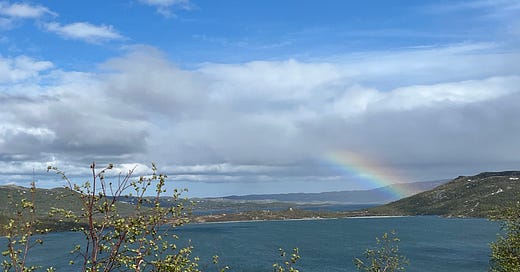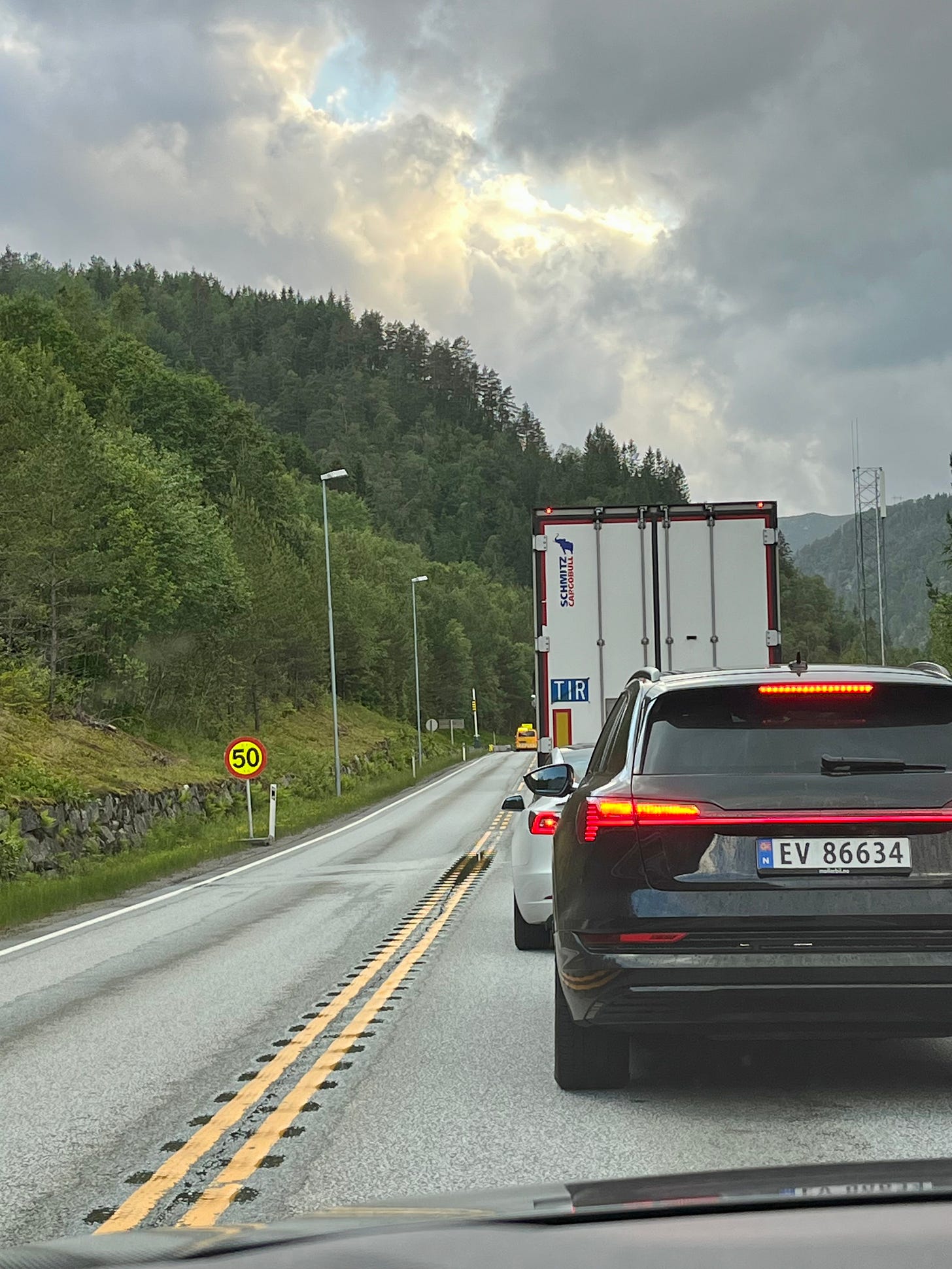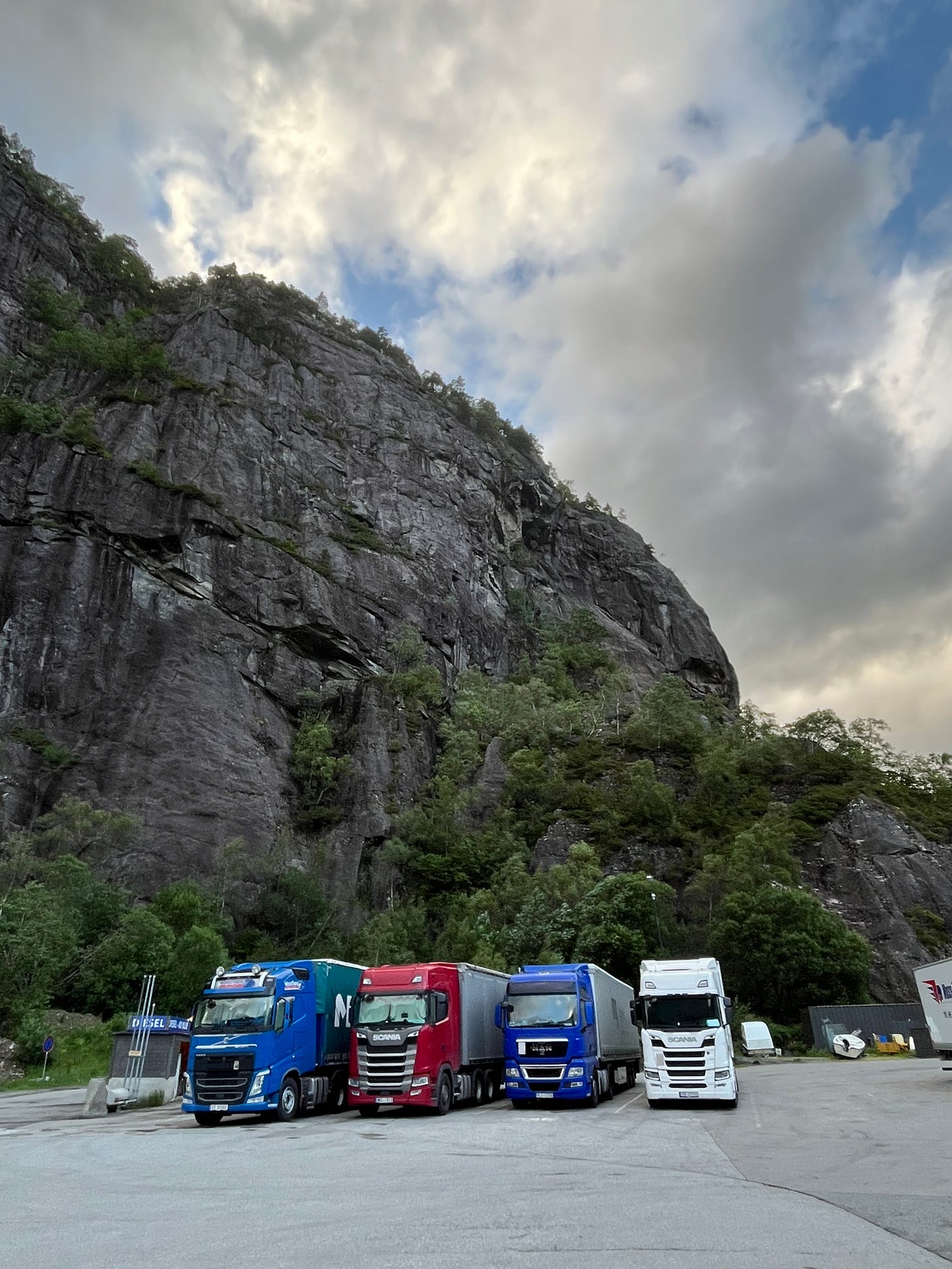Knowing what I know now, I wish we had taken the train from Oslo to Bergen because the drive, while beautiful, was treacherous in the middle! But more on that soon enough.
The drive started out benignly. Norway isn’t highly populated and we were heading out of Oslo on a Monday, so there weren’t many people on the road. What I didn’t know ahead of time but would soon learn is that Norway has very few motorways or what in the US I would refer to as a freeway with multiple lanes, a shoulder, and a center divide. Most of Norway is covered by national and county roads that are more akin to local highways in the US, with one lane in each direction, no center divide, and no shoulder. Top speed is 80 kph (50 mph) and in some places it’s only 70 or 60 kph (44 or 37 mph); that’s because the roads are curvy; they follow the natural contours of the land, which were largely shaped by glaciers. So making the 465 km (~290 mile) journey between Norways’s two biggest cities takes at least 7.5 hours, and that’s with good weather, no road construction (or accidents), and no stops. (Spoiler alert: It took us much longer.)
While that distance is like going from Seattle, WA to Eugene, OR -or- Dallas, TX to Galveston, TX, the actual drive time is more like going from Portland, OR to Sacramento, CA -or- Dallas, TX to El Paso, TX. (Just referencing drives I know!)
But let’s start at the beginning. The first part of the drive, between Oslo and Geilo, was gorgeous. The greenest fields you ever did see, plus wildflowers everywhere that reminded me of the superblooms in California; the lupine in particular were spectacular. You can get a sense for it through some of the photos here. Much of the route ran alongside water, at times narrow and other times wide like the Mississippi. The road wasn’t straight, but it wasn’t difficult to drive. Sadly, I couldn’t snap photos since I was driving, but the kids got a few (no wildflowers, unfortunately).
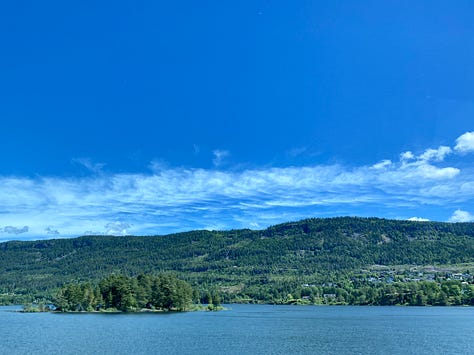

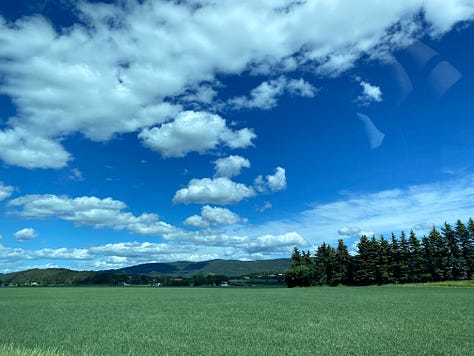
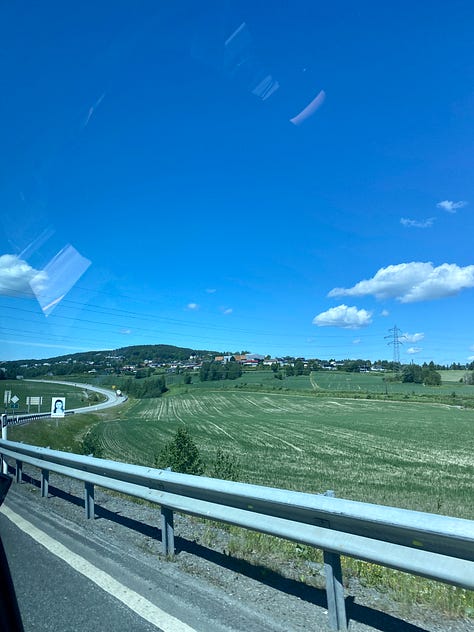
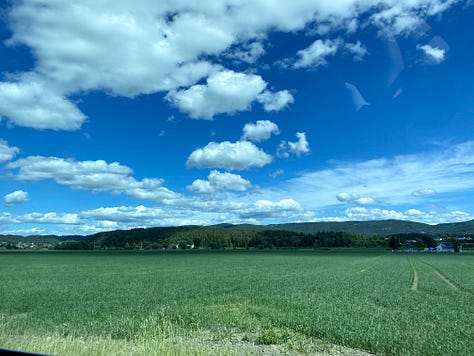

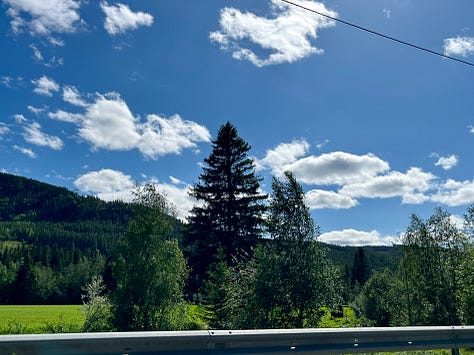
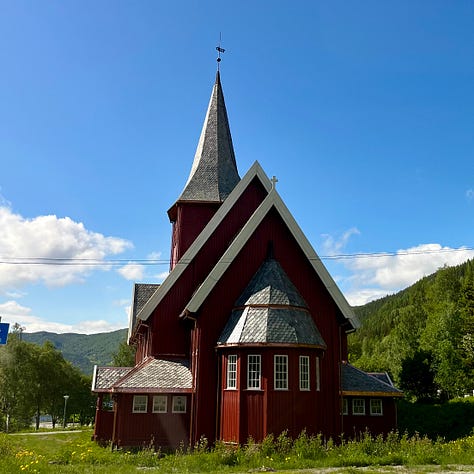
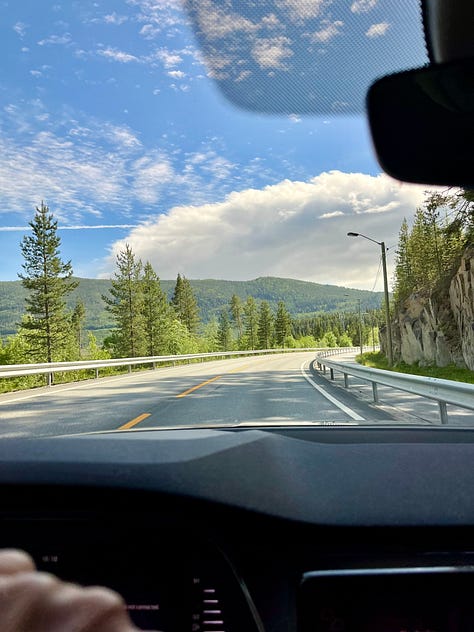
We stopped in Geilo (a ski town) for a snack and bathroom break thinking it was roughly the halfway point. It was much chillier and windier than in Oslo, but we weren’t spending time outside, so we didn’t bother digging our jackets out.

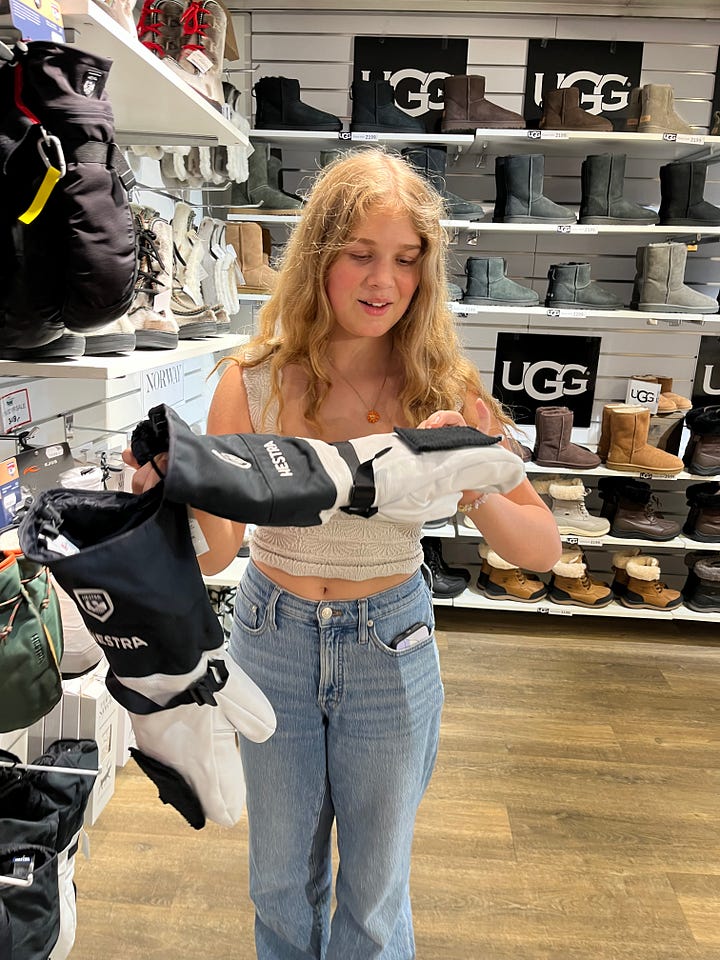
I recalculated and realized we weren’t quite halfway, so I said I’d drive a bit farther. Not long after leaving Geilo, the road split and we left the beautiful water we had been following behind—and the nice weather, too. We started to climb in elevation, but it was gradual, so it didn’t feel dramatic.
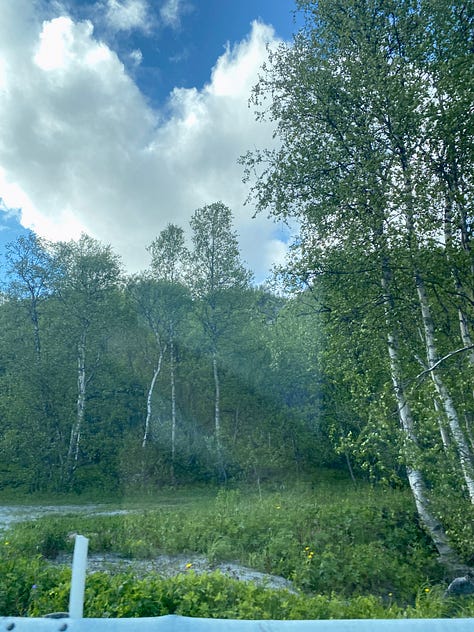

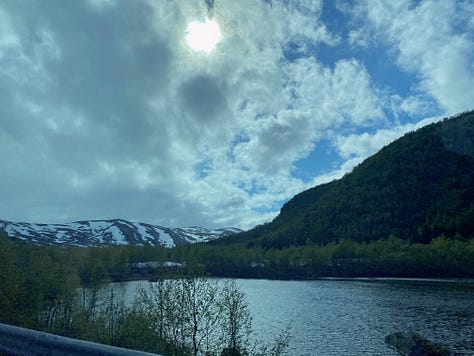
It started to rain, but the sun was also out, which meant:
Eventually we reached what I now know is Hardangervidda, the largest high-altitude plateau in Northern Europe. Gone was the verdant green landscape; we had entered what felt like a desolate, arctic expanse. Indeed, the plateau is above the treeline; if you’ve driven through Colorado’s high country, you’ll know what that looks like.
The Hardangervidda’s alpine climate supports arctic animals and plants — something not possible anywhere else so far south in Europe. Supposedly there are even reindeer (which normally live farther north), though we didn’t see any. In fact, we didn’t see much of anything — people or wildlife. Just lots of snow and vast, open land. Chris and the girls loved the landscape and hopped out on a short stop to venture all the way to the water and to touch some snow. Brr!

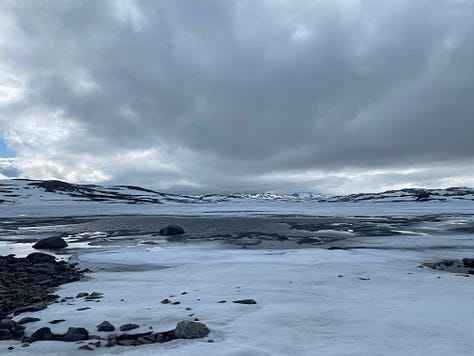
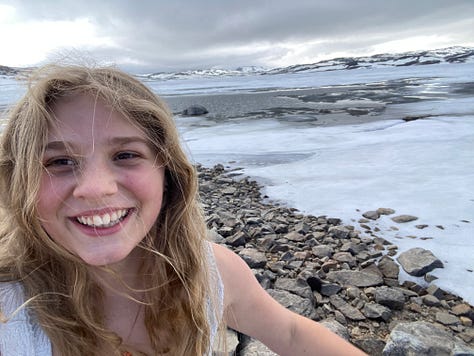
Fun fact: Apparently Hardangervidda is where parts of The Empire Strikes back were filmed.
The road across the plateau was marked with tall, wood poles at regular intervals. I didn’t know what they were for, but it turns out they mark the edge of the road so snowplows can clear the full width of the highway and keep it open in the winter. Can you imagine having that job? Wow.
Once we got to the west side of the plateau, things got spicy. I was still driving and that ended up being a mistake. The portion of the highway between Haugastøl, at the edge of the plateau, and Eidfjord, ~70km (42 miles) west, descends ~1000m (3280 feet) in elevation via a dramatic drive that I was not at all prepared for. One part of the road has an 8% grade. (For comparison, it would be a bit like driving from Truckee, CA down to Colfax, CA but on a two-lane highway with no shoulder or center divide and lots more curves.)
This stretch may well be one of Norway’s official scenic routes, but it is also now on my list of “never need to drive again” routes. Pretty sure Chris has banned me from sitting behind the wheel for it, anyway. Why? On a scale of 1-10, my anxiety was 11+. The road alternated between tricky turns and dark tunnels that felt like they had been bored to the center of the earth (okay, maybe just to me, but still). And it was raining.
Chris suggested that I pull over so I could get my anxiety under control. I did, and sat there taking deep breaths. Meanwhile, he and Natasha hopped out to go see what turned out to be the famous Vøringsfossen waterfall. Even once I knew it was there I couldn’t bring myself to get out to see it.
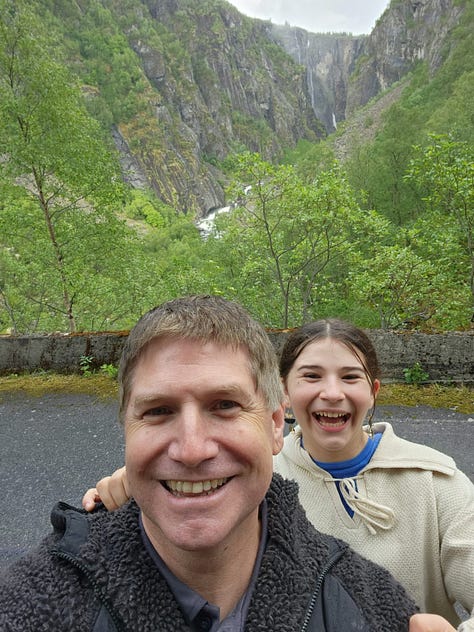
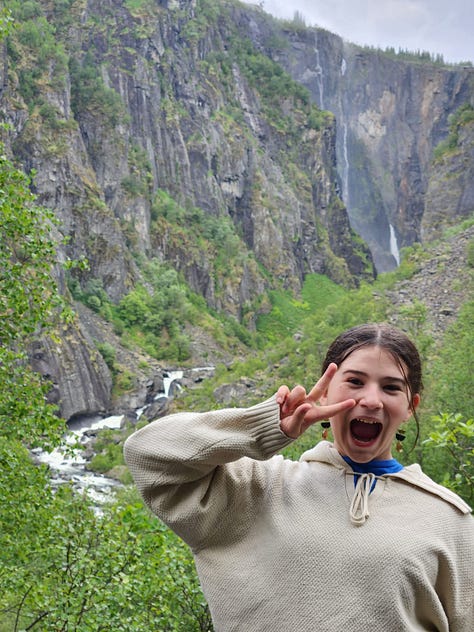
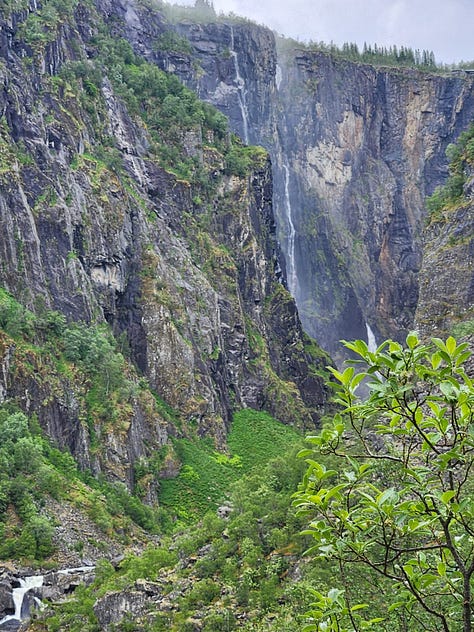
After the stop, I resumed driving; Chris offered to drive in my place, but I weirdly felt better being the one in control of our speed. I was terrified of going over the side of the road and careening to our deaths. Little did I know this was the start of the Måbødalen Valley, where the road makes a full 360-degree corkscrew loop through a dark tunnel and then continues descending through twists and turns toward the bottom of the valley. Whew!
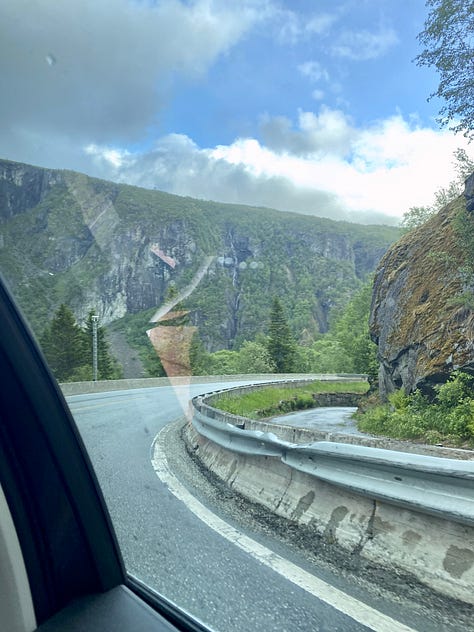
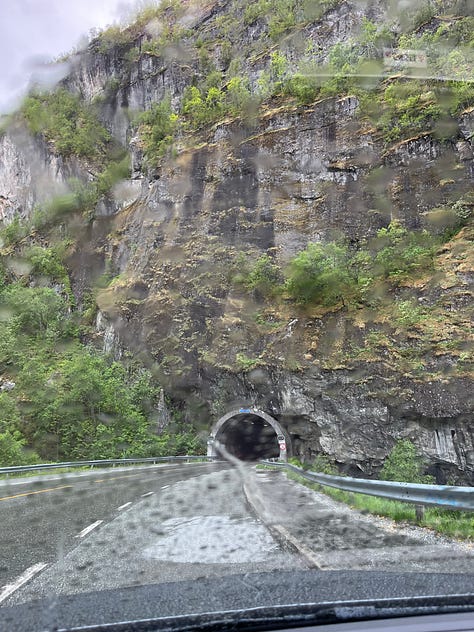
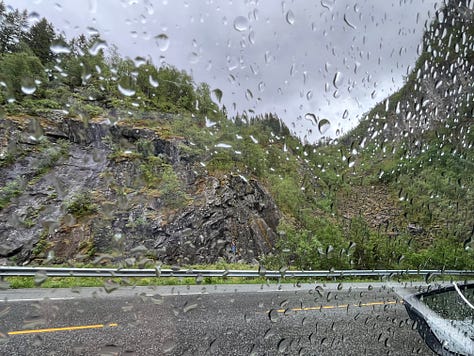
I eventually made it to the bottom, where the road flattens out. There was a lovely spot to pull over, so I did just that, getting out of the car to stretch my body and shake out the rest of the anxiety. The views were stunning.
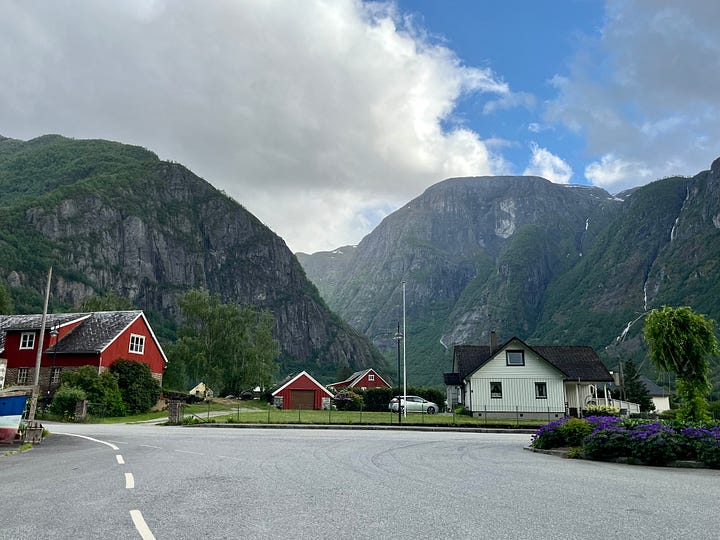
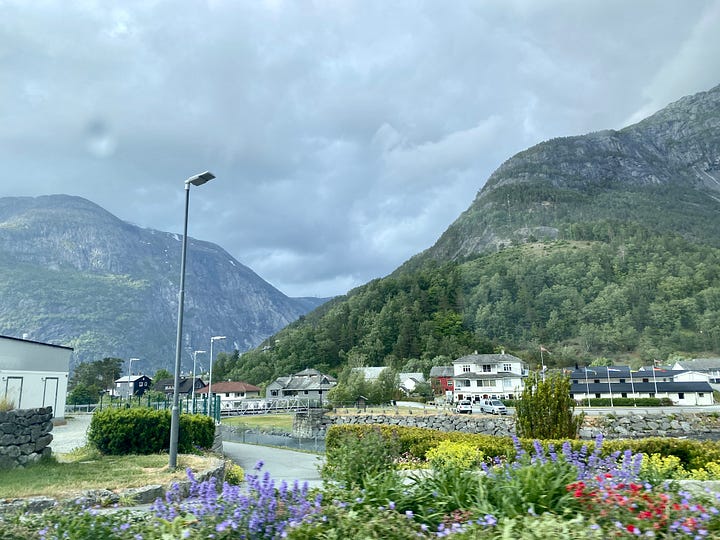
At this point we still had 2.5 hours of drive time according to Google and we knew it would be longer, so we didn’t dilly dally. The sun broke through the clouds here and there as we drove next to the Hardangerfjord. It was quite pretty.
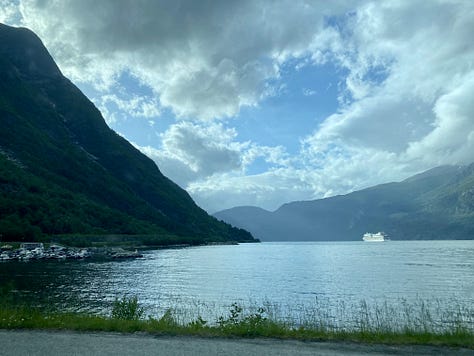
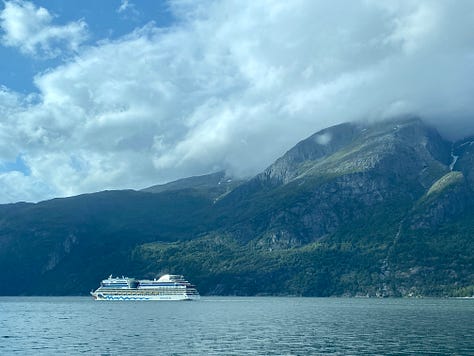
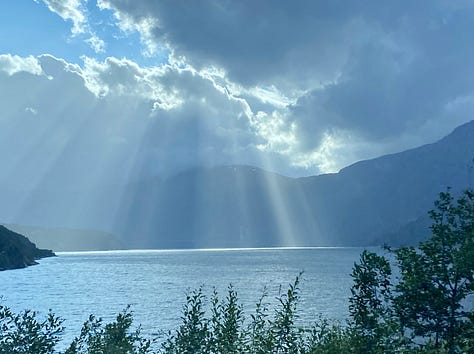
Before long we crossed the Hardanger Bridge, the longest suspension bridge in Norway and one of the 20 longest in the world. It’s especially unique because it’s anchored on both ends by tunnels. Prior to its construction in 2013, cars had to cross the fjord by ferry. [See the end of the post for some videos.]
Our drive continued fairly uneventfully for a little while, until it didn’t. Of course, we couldn’t just make the rest of the drive in peace. Instead, we came to a complete stop on the highway right after a blind curve, behind a line of other cars, with no idea as to why. With no way to get any information, we jut sat there like sitting ducks; we were worried a semi was going to come around the blind curve and plow into us. Once a few more cars had safely come to a stop behind us, we relaxed a bit. In total, we probably weren’t stopped more than 15-20 minutes, but it felt like an age.
Eventually the line of cars started going, only we had to follow a lead car at a slow pace because there was road/tunnel work being done and the stretch ahead had only one lane open intermittently. It was a bit surprising that this work was being done at 8:30/8:45 PM, but I suppose with only so many months during the year to get repair work done, you maximize the good months. We stopped at a gas/convenience store once we got through the caravan to use the restroom and grab a snack. It was 9:00 PM by this point and, while we still had enough daylight to make it to Bergen, I was antsy to keep moving.
Not 15 minutes into driving, we came to a complete stop on the highway again. Le sigh. This time there was a worker who told us it would be about a 15-minute wait. I turned the car off and we played Wordscapes to pass the time. I was glad I wasn’t standing in the rain. Once the caravan started moving, we passed multiple groups of workers huddled together, talking. Chris cracked a joke about Cal-Trans; it definitely fit the moment. (If you’re from California, you’ll understand the reference.)
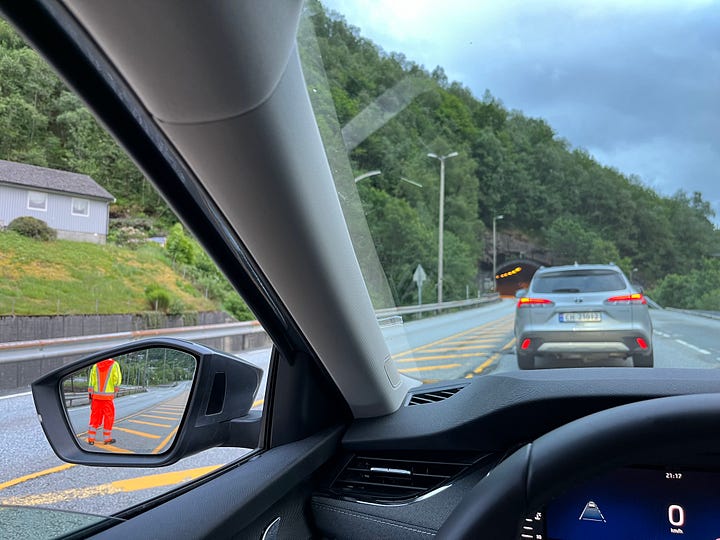
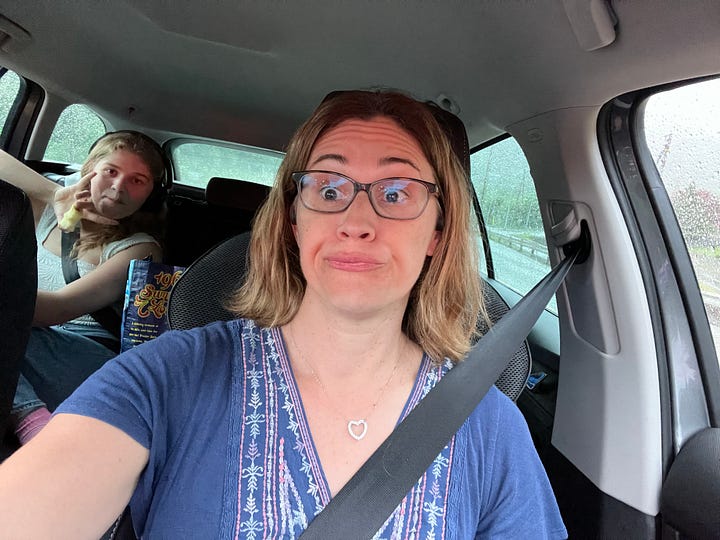
Anyway, around 10:30 PM we finally pulled into the driveway of our AirBNB. It had only taken us 9.5 hours to make the 7.5 hour-drive. I joked that I was going to take the train back and Chris could drive. It remains to be seen whether I was actually joking.
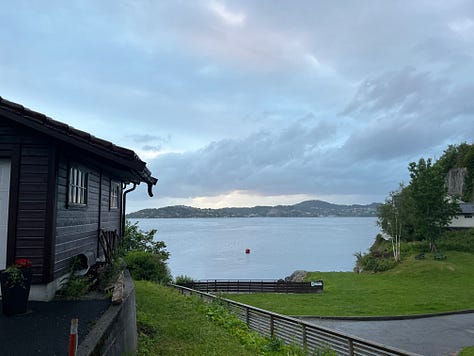
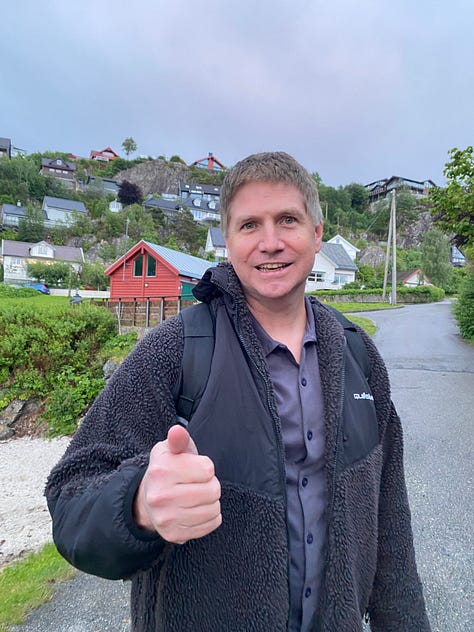
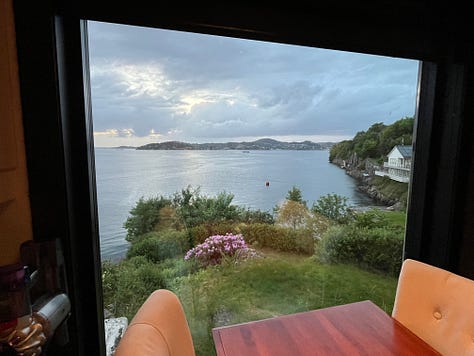
Lessons learned:
I should not drive on windy/curvy roads.
Road trips across Norway will take longer than expected, for multiple reasons.
If you can take a train, maybe do that instead; you’ll get to see all of the nature without the stress.
While the speed limits posted may say 80 kph, it is not actually possible to drive that fast into and through most of the curves; whereas the US usually posts reduced speeds going into curves, Norway mostly does not, and it really messes with your head!
The speed limit on Norway’s highways changes constantly; one stretch is 70 kph, then it’s 80 and then suddenly it drops to 50 but climbs to 60 and then jumps back to 80. Often there’s no discernible reason and little warning. So it’s not enough to pay attention to curves and tunnels and oncoming traffic; you also have to constantly watch the speeds so you don’t get a ticket. And no, the police won’t necessarily pull you over; you’ll just get a ticket in the mail from a speeding camera. I can’t wait to see whether I got one, despite driving so far under the speed limit for so much of the trip.
I should not drive on windy/curvy roads (it bares repeating).
*****
You can watch the entire drive from the Vøringsfossen waterfall area down the Måbødalen Valley to the Hardanger Bridge (not our video, of course); note the parts of the drive (after the four curvy tunnels) where the center line disappears and the lanes narrow (~3:27) and yet you still need to share the road with busses and semis (eek):
And here’s a cool visual of the tunnels we passed through. The second one in the video above is the one that does the 360-degree loop, crossing under a different tunnel. Norway has some amazing engineering.
You can also watch the journey across the Hardanger bridge below (I recommend watching at 1.5x-2x speed on mute):
Lastly, here’s a video I found of someone who made the same trek as us from Oslo to Bergen, only he deliberately broke it up and enjoyed the journey (ha!).
Have you driven the windy highways in Norway? What was your experience? Have any dramatic stories from driving in other countries? Please share!
Want more stories about our adventures driving in other countries? Here’s one from exactly two years ago, in Portugal.

